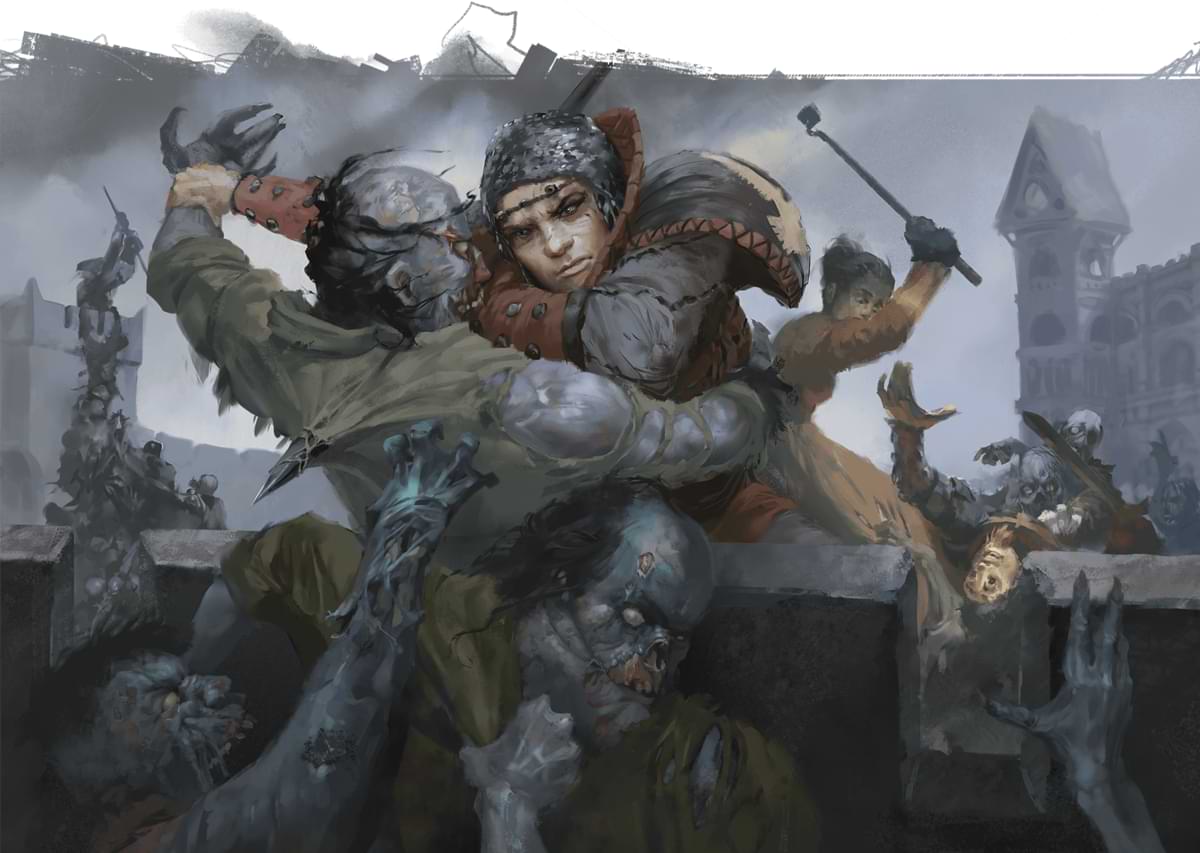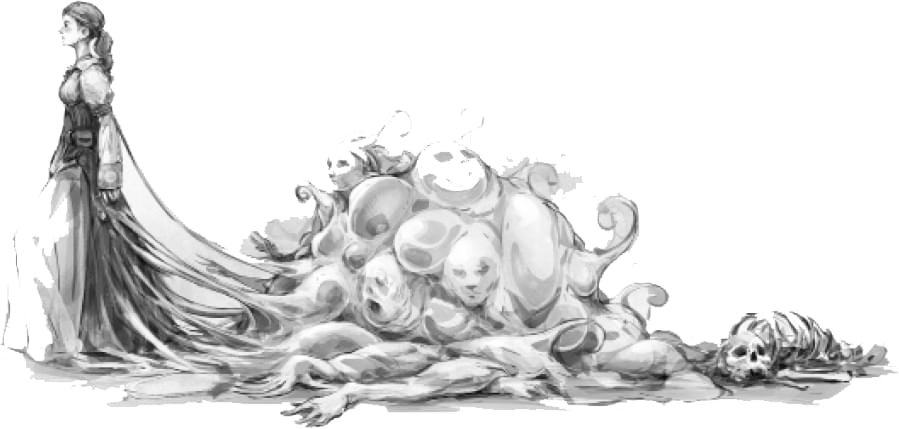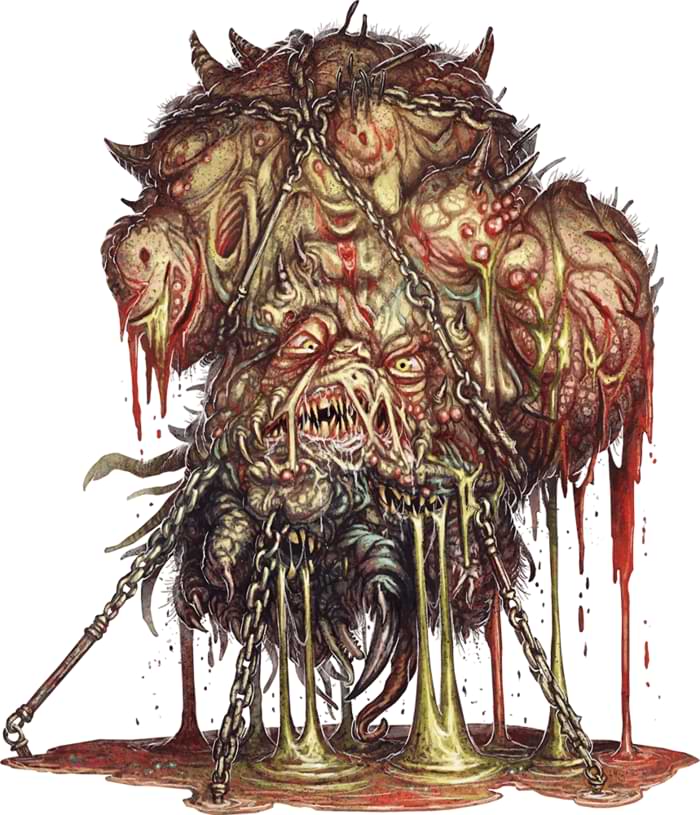Spooky season is in full swing and it’s the perfect time to introduce a little terror into your Dungeons & Dragons game! Whether your adventures lean more into combat or roleplay, you have plenty of D&D monsters to torment your players with. Here are a few to bring into your games and how to raise the stakes.
Setting limits on horror in D&D
Approach your players before exploring horror themes in your games. Ask them what genres of horror they prefer and any hard lines they might have. The sibriex, for example, is a gory monstrosity that leans heavily into body horror and could make some players uncomfortable — or straight up nauseous — by virtue of just how gross it is!
1. Zombie

Zombies appear as they did in life, showing the wounds that killed them. However, the magic that creates these vile creatures often takes time to run its course. Dead warriors might rise from a battlefield, eviscerated and bloated after days in the sun. The muddy cadaver of a peasant could claw its way from the ground, riddled with maggots and worms. A zombie might wash ashore or rise from a marsh, swollen and reeking after weeks in the water.
Source: Player's Handbook
Let's kick things off with a horror classic: zombies! There’s a reason why these monsters have captured the hearts and minds of horror fans for over 50 years. The very idea of an enemy that can’t be stopped by normal means is scary enough, but when that enemy can be the reanimated corpse of a dear friend or loved one? That’s when the terror really starts to kick in.
Mechanically, zombies might not seem like much. They have a challenge rating of 1/4, a few hit points, and a slow speed. But there are a variety of ways you can spice up this horror classic to help this brain-eating creature have your players fleeing.
How to bring the horror
As any zombie fan will tell you, these monsters are at their deadliest when moving in groups, so consider overwhelming your party with a zombie horde. (If the characters choose to fight, keep combat flowing by using the rules for handling mobs in the Dungeon Master's Guide.) Alternatively, you could lure the adventurers to cursed ground, where you can grant a small group of zombies advantage on Constitution saving throws made for Undead Fortitude. This would help them survive longer in combat, better emulating a zombie's stubborn unwillingness to die.
To really bring the pain or just add variety to the zombies the characters encounter, you can tweak the zombie stat block or pepper in other kinds of zombies:
- Sprinters: For fast-moving zombies, allow them to take the Dash action as a bonus action.
- Rampagers: Tack on Multiattack for truly ruthless zombies.
- Hiders: Get the jump on the characters by giving zombies the False Appearance trait. While they remain motionless, the zombies would be indistinguishable from corpses.
Setting the stage is important, too. For example, if the characters are in the middle of a dungeon crawl, you could describe the growing stench of rot and the distant sound of shuffling feet. As the characters round a turn into a large cavern, they discover a mob of zombies that slowly turn in their direction. You can raise the stakes by placing the party's destination — like the exit to this hellish dungeon — on the far side of the cavern.
If you prefer more narrative horror, don't shy away from pulling at your players' heartstrings. A zombie in the crowd could be the undead corpse of a beloved NPC, a character's family member, or even a former member of the party themselves.
2. Elder oblex
By experimenting on the slimes, jellies, and puddings that infest the depths of the Underdark, mind flayers created a special breed of ooze, the oblex — a slime capable of assaulting the minds of other creatures. Cunning hunters, these pools of jelly stalk prey, searching for the memories they so desperately crave. When oblexes feed on those thoughts, sometimes killing their victims, they can form weird copies of their prey, which help them to harvest even more victims for their dark masters.
Source: Mordenkainen’s Tome of Foes
What's more terrifying than a foe disguised as a friend? The elder oblex collects memories and creates perfect simulacrums of its victims using gooey tendrils that can extend up to 120 feet away.
Though not the most mobile of monsters, the elder oblex is ever-evolving, taking on not only the memories and languages of the creatures it consumes but their proficiencies as well. Its ability to impersonate anyone it has devoured in this way, along with a bevy of innate spellcasting options, makes it a truly cunning predator that can hide in the shadows until it’s ready to strike.

How to bring the horror
Though the simulacrums the elder oblex creates are perfect in every way, they do have two noticeable weaknesses: the slimy tether anchoring the false face to the pile of ooze itself, and the faint smell of sulfur the simulacrum gives off. Utilize the elder oblex in a setting where it has space to hide but can still reach out with its tendrils to tempt new prey. Perhaps family or friends that have been consumed awaken your adventurers in the night, begging them to follow to an abandoned warehouse or into the sewers.
Alternatively, you could have the elder oblex run its own tavern. Able to impersonate 2d6+1 of its victims, the elder oblex could be the tavernkeeper, the drunkard and other patrons, and the bard who sings a joyous song from a dimly lit corner of the room. The simulacrums could feed false information to the characters and be none the wiser to the fact that an elder oblex is hiding in the floorboards beneath their feet.
The elder oblex’s innate spellcasting allows it to be a master manipulator, confusing and confounding the party. Their ability to cast charm person, detect thoughts, and hold person at will allow it to fully prepare the stage before moving in for the kill. Additional spells like confusion and hallucinatory terrain force the characters to question their very reality.
3. Sibriex
Thought to be as old as the Abyss itself, sibriexes haunt remote parts of the plane, where they use their vile abilities to breed new horrors and apprehend forbidden lore. Rivulets of blood and bile cascade from a sibriex’s body. Where these noxious fluids hit the ground, the landscape becomes polluted.
Source: Mordenkainen’s Tome of Foes
For D&D groups that enjoy body horror and gore, the sibriex is a demonic fiend that can change the physical makeup of its enemies, eventually warping them into unrecognizable abyssal wretches fully under the sibriex’s control.
A sibriex is so disgusting, even being within 30 feet of it is bad for your health. It is truly one of the most horrific monsters in D&D and, should your party choose to face it head-on, offers a fate worse than death for those it overcomes.
How to bring the horror
 Just let your players see it. No, seriously, the sibriex is absolutely hideous. Lean into your narration of the monster's mangled, bleeding, and bile-dripping flesh and watch as your players' eyes widen in horror.
Just let your players see it. No, seriously, the sibriex is absolutely hideous. Lean into your narration of the monster's mangled, bleeding, and bile-dripping flesh and watch as your players' eyes widen in horror.
To lead up to the party's encounter with a sibriex, drop clues of its influence by detailing corrupted vegetation and the remains of its victims. A sibriex fills the lands it presides over with demonic monsters like rutterkins and abyssal wretches, which can soften up the party before they meet this supremely vile creature.
In combat, the sibriex’s Warp Creature ability is the ultimate fear generator. The characters won't be as concerned with being bludgeoned to death as they will be at being transformed into a gibbering demon — a fate that can only be undone by wish.
Wrapping up
As scary as monsters are, the real terror comes from how you weave them into your story and haunt your players with them until the final fateful encounter. If you're looking for more creatures to terrorize your characters with, check out other monsters found in Mordenkainen’s Tome of Foes.
For ideas on the perfect setting to spook your players, the domains of dreads found in Van Richten's Guide to Ravenloft are a great place to start. Or you can create your own domain of dread, as we did with Critical Role's Taliesin Jaffe!
Andrew Strother (@RollPersuasion) is a marketing consultant and tabletop content creator. He’s the host of the podcast Roll for Persuasion, where he interviews creators and entertainers about the nerdy things they love, as well as being the co-creator and a co-star on Second Star to the Right: A Neverland Adventure; a D&D actual-play game set in the magical world of Neverland.








-
View User Profile
-
Send Message
Posted Oct 29, 2021Creepy.
-
View User Profile
-
Send Message
Posted Oct 29, 2021Sibriex’s are really gross, and yet also have a Charisma of twenty. Proof it is literal social skills and the ability to manipulate people, not good looks.
Oblex are definitely great for horror.
-
View User Profile
-
Send Message
Posted Oct 29, 2021Frozen Memories is a free adventure featuring the Oblex.
-
View User Profile
-
Send Message
Posted Oct 29, 2021I love the idea of the oblex tavern! That would be especially fun in a mind flayer-driven campaign, as the oblex originated as mind flayer servants and creations, and may very well remain as such in some colonies. I would personally have everyone in the tavern be oddly pushy to get characters to rent rooms there, obviously if you don't wanna do a TPK, and subtly if you want to either kill or really scare the characters. When the characters retire to their (separate, isolated) rooms, and sleep, trance, sentry's rest, etc. the oblex itself will ooze up through the floorboards or fight through its simulacrums to kill the characters and add new guises to their collection.
-
View User Profile
-
Send Message
Posted Oct 29, 2021I used an Elder Oblex in a small room. Every turn it created a new false person (including two players) in spots near the back line players. No one was safe. Everyone was terrified.
edit: it was actually in a tavern kitchen. I’m running tomb of Annihilation and threw it in. It had killed Kaya of Kaya’s House of Repose. My players were VERY suspicious of how Kaya was acting strange. She also smelled slightly of sulfur like the yuan-ti. I had the yuan-ti make it instead. My players were so scared as two of them got hit with the memory drain. On the following turn false copies were made next to their allies to attack them. It is such an under appreciated monster. I’m so happy to see in here.
-
View User Profile
-
Send Message
Posted Oct 29, 2021Guys, guys, hear me out:
A Large Gibbering Mouther that splits like an ochre jelly. Or perhaps an oblex created by the sacrifices of abducted humanoids, whose forms they take before absorbing more people? Oh, I know! A creature with the statistics of a flameskull, but with the Incorporeal Movement feature and reflavored as a mage's spirit! Or, I don't know, a giant angler fish. Now that's scary.
Now this, this is one of the prizes of my twisted creativity: A zombie or Strahd zombie infested with a swarm of maggots that burrows out of it when it dies!
I also think that quite a few more monsters have dreadful capabilities as a one-shot boss or to add a touch or horror to your campaign, such as the nothic, oni, nosferatu, dullahan, scarecrow (if you're feeling particularly evil, you can give it a scythe and some more abilities to go with it... perhaps an AoE ability where it sweeps its scythe (a reach weapon that deals slashing damage) in a ten-foot radius, making everybody in it take slashing damage? Maybe it has Multiattack if it goes under half of its hit points, or is accompanied by a swarm of ravens?), gallows speaker, sea spawn, most star spawn, or pretty much any hag.
-
View User Profile
-
Send Message
Posted Oct 29, 2021I wrote an Ooblex adventure for my party, basically John Carpenters the thing in DND. Have your players be brought to a remote location with several npcs you've written, roll a dice and pick one of them to be the Ooblex initially. and then have the party be cut off from the outside world and need to hunt down the ooblex before it can replace people, ideally having it be able to traverse the area through some hidden means the players wouldn't think of at first, like vents or pluming.
Can start the adventure with them being brought there by reports of a crashed nautiloid, but inside they find nothing but a broken egglike shell the smells like rotten eggs.
-
View User Profile
-
Send Message
Posted Oct 30, 2021I'm going to homebrew some of these! [reply to HallaarKiirgalan].
EDIT: Mage Spirit, Gibbering Jelly, Giant Angler Fish, Maggot-Ridden Zombie, Scything Scarecrow.
-
View User Profile
-
Send Message
Posted Oct 30, 2021The oblex is probably my favorite D&D 5e monster. Such a cool concept to mess with players, I've had at least one in most of my games.
-
View User Profile
-
Send Message
Posted Oct 30, 2021AMONG US
-
View User Profile
-
Send Message
Posted Oct 30, 2021I've done the zombies with a swarm inside, it's a great way to add an additional layer to an otherwise potentially uninteresting combat
-
View User Profile
-
Send Message
Posted Oct 30, 2021Creepy/cool!
-
View User Profile
-
Send Message
Posted Oct 30, 2021These are great horror ideas and all but the scariest thing is probably... I forgot... What are we talking about again?
-
View User Profile
-
Send Message
Posted Oct 30, 2021*Fast-forwards to me closing out of the article and forgetting everything about it*
-
View User Profile
-
Send Message
Posted Oct 30, 2021Don't think it has to be one or the other. A 20 Wisdom can be a deep understanding about the motivations of people through a lifetime of police work, an empathic connection to others due to an alien brain, or a really good sense of smell. Using your imagination to justify the number is encouraged.
-
View User Profile
-
Send Message
Posted Oct 30, 2021All these ideas are great! I would especially encourage people to use the giant anglerfish. I used one in a scary adventure for some friends (modified brown bear stats, there weren't many of em' and they were low level), and it had a great impact. The characters were swimming around in pitch blackness when suddenly a light flashed in the darkness, luring them in...
I made up for the relatively weak stats by giving it charming abilities and good tactics, but really any large carnivore could be altered into one of these.
-
View User Profile
-
Send Message
Posted Oct 30, 2021its proof that it CAN be social skills and force of personality. but it can still be tied up in how physically attractive someone is if thats what they want. yes, beautiful people can and often do have low charisma. it's true nobody can say, "you cant be beautiful because you only have a charisma of 8", just like how nobody can say "charisma has nothing to do with attractiveness". Its all about how the player wants to play.
-
View User Profile
-
Send Message
Posted Oct 31, 2021for zombies you could use the walking dead tv whisperers idea, have some disguised non zombie NPCs in the zombie hoard. Perhaps NPC rogues that dodge when you attack them, pull a knife out their tattered clothes and sneak attack you.
Also have zombies randomly grapple and shove characters prone, that will really scare players and add a bit of zombie movie feel. Add the whisperers idea and have the disguised rogues help the zombies grapple and drag the victim into the hoard. Any zombie that doesn't get to attack should ready a grapple.
-
View User Profile
-
Send Message
Posted Nov 1, 2021It cannot be repeated enough that the amazing monster that is the oblex was created as a Make-A-Wish by the amazing Nolan Whale. One of my favorite monsters with one of my favorite origin stories!
-
View User Profile
-
Send Message
Posted Nov 1, 2021Spawn of Kyuss is totally better than zombies... Higher CR, infectious, creepy, and can even have range attacks throwing it's worms.